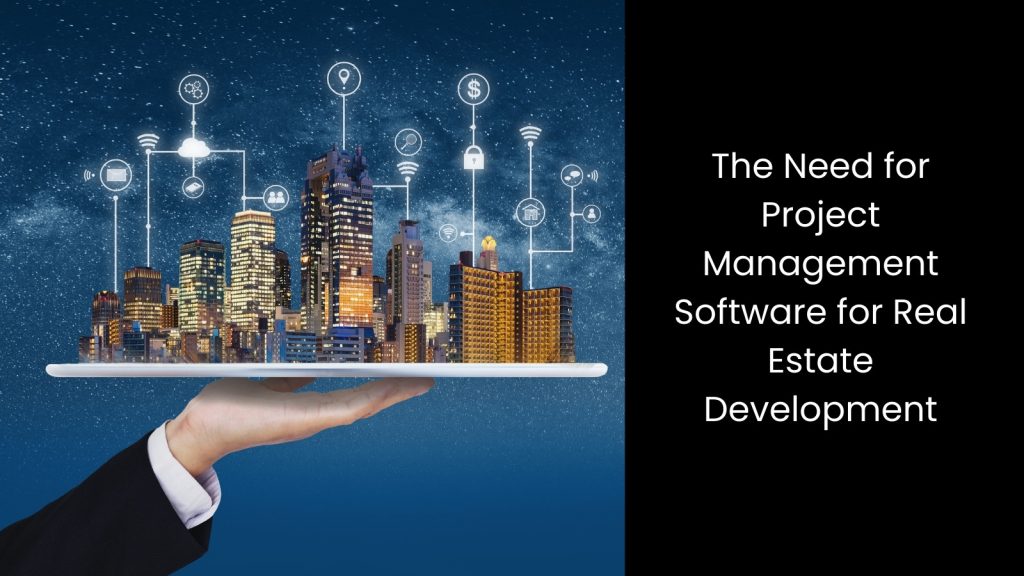What real estate projects demand the most is, undoubtedly, ‘precision’ ‘ but let’s be real! Those mismanaged schedules, cost overruns, and communication breakdowns happen all the time, and there is no way the real estate industry can avoid them. If we look into this realm more closely, we can witness the developers juggle multiple teams, endless paperwork, and high-stakes investments, yet many still rely on outdated methods that slow things down. That is where choosing the best project management software for real estate development changes everything. But how do developers pick one that actually works for their needs?
This is why we decided to guide you in choosing the best project management software for real estate development in this article.
We will explore
The Need for Project Management Software for Real Estate Development

First, we will understand why exactly the real estate developers need robust PM software.
- The truth is that real estate development project management software makes handling complex projects way easier, as it has the power to keep everything organised, from planning to execution.
- If you are an insider, you certainly know that developers, architects, and contractors juggle multiple tasks, and a reliable project management tool ensures smooth coordination. Real estate teams can track budgets, deadlines, and tasks in real-time without losing important details.
- Since construction involves different stages, from design to handover, using software designed for real estate helps manage the entire project lifecycle with clarity. Modern construction relies on building information modelling, and integrating it with agile project management methods speeds up decision-making. Developers do not have time for outdated methods, so agile development processes improve efficiency and adaptability when unexpected changes pop up.
- Therefore, managing workers, materials, and costs can become overwhelming, but smart resource allocation tools prevent overbooking or shortages. Instead of relying on endless spreadsheets, a visual project dashboard presents data in a clear and digestible format, keeping everyone on the same page.
Strategically Choosing the Best Project Management Software for Real Estate Development

Assess Your Project Needs
If you are not certain of the project goals, there will be no further development.
This is why choosing the right real estate development software starts with knowing exactly what your firm needs because not every tool fits every project. Developers, contractors, and property managers handle different tasks, so understanding priorities saves time and money.
Some focus on cost management, making sure projects stay within budget, while others prioritise resource management to allocate workers and materials efficiently. Teams that deal with large-scale developments need construction management features, while a home builder might look for tools that streamline planning and execution.
If a company handles multiple properties, strong asset management ensures smooth tracking of buildings and infrastructure. Organising files, blueprints, and contracts gets messy without proper document management, so selecting software with structured data management prevents information from getting lost. Those dealing with commercial properties must focus on facility management for maintenance scheduling and operational efficiency.
If selling homes or units plays a big role, built-in sales management features help track leads and transactions without relying on separate systems. Planning long-term growth means integrating strategic planning tools to make informed decisions rather than scrambling at the last minute.
Evaluate User-Friendliness
Nobody wants to waste hours figuring out complicated real estate software development when they could be focusing on actual projects. A tool with confusing menus and clunky design slows everything down, making teams frustrated instead of productive.
This is when choosing software with an intuitive interface keeps everyone moving without unnecessary training.
When teams handle multiple tasks like planning, budgeting, and reporting, easy navigation ensures they find what they need instantly. Developers, contractors, and clients must track project progress without getting lost in endless clicks, so smooth project workflows matter more than fancy features that barely get used.
Builders also manage the builder-client relationship, and a user-friendly platform makes communication effortless, reducing misunderstandings. Pre-built project templates help teams set up new developments quickly instead of building everything from scratch, saving valuable time.
This is where a simple, well-designed system means fewer errors, faster adoption, and a more efficient workflow where everyone stays focused on actual work instead of struggling with complicated tools.
Check Integration Capabilities
A messy tech stack slows down real estate project management since teams jump between disconnected tools instead of focusing on actual work.
Choosing software that connects with existing apps prevents frustration and wasted time.
All the parties in this industry rely on different platforms for design, accounting, and communication, so seamless integration keeps everything flowing. Linking a client database with a CRM avoids double entries while syncing with accounting systems simplifies financial tracking. Similarly, construction teams using AutoCAD or Revit need direct connections to project plans, making sure designs update instantly without extra steps.
You may have noticed that poor integration disrupts business processes. This is one thing that forces teams to manually transfer data, which increases errors and delays. Strong connections also improve adoption because employees stick with software that works smoothly instead of struggling with constant workarounds. So, yes, a well-integrated system enhances stakeholders’ collaboration since architects, engineers, and investors access the same data without endless email chains.
There is no doubt that such smart choices today prevent bigger headaches down the road, making integration a must-have, not an afterthought.
Assess Task and Workflow Automation
Managing real estate projects gets messy fast when teams rely on manual tracking instead of automation. Choosing software for land development with built-in workflow automation removes unnecessary steps, keeping everything on schedule without constant follow-ups.
Insiders like developers, contractors, and property managers have to face many chaotic situations during multiple project stages. Therefore, setting up automated approvals, task assignments, and reminders ensures nothing slips through the cracks. A system that automatically updates databases saves time because teams do not have to enter the same information repeatedly.
It is indeed a fact that certain delays usually happen when waiting for client decisions, but automated notifications speed up the process by keeping everyone in the loop. When approvals move faster, construction stays on track, and last-minute surprises are avoided. Strong task management features assign work instantly, so no one waste time figuring out their next steps.
As you can see, automating workflows improves operational efficiency, reducing the need for constant check-ins and email threads. Instead of chasing updates, project managers focus on actual development while the software handles repetitive tasks.
Look for Customisation Options
Every real estate project runs differently, so using one-size-fits-all software slows everything down instead of making things easier. Picking a real estate management tool with strong customisation ensures teams work the way they need to, not the way the software forces them to. Let us explain this.
Industry people follow unique project workflows, and a flexible system lets them adjust dashboards, automate tasks, and track project progress in ways that fit their daily operations. A rigid tool makes simple tasks complicated, forcing teams to waste time on workarounds instead of focusing on actual development.
This is how customisable reporting helps businesses pull the exact data they need without digging through irrelevant details. Since every client has different expectations, having the ability to tweak project phases, task assignments, and approval processes keeps everything aligned with stakeholder needs.
In one way, large-scale projects depend on strong infrastructure, and software that adapts to different locations, budgets, and team structures avoids unnecessary bottlenecks. Ignoring customisation leads to extra costs because businesses either struggle with inefficient systems or pay for expensive add-ons.
In another way, keeping stakeholders on the same page becomes easier when project tracking, notifications, and workflows match how teams actually work. Flexible tools make real estate development smoother, turning complex processes into a structured, manageable system.
Analyse Reporting and Analytics
Handling real estate projects without strong reporting feels like driving blindfolded. Will you agree?
One thing is certain! If the real estate teams go without proper reporting, they will miss risks, budgets will spiral out of control, and decisions will rely on guesswork instead of facts. So, choosing real estate development project management software with powerful dashboards and analytics keeps everything clear, making complex data easy to understand at a glance.
One thing is that developers track costs, timelines, and task progress without digging through endless spreadsheets. Real-time financial tracking helps businesses monitor expenses, ensuring projects stay within budget instead of running into unexpected overruns. Another thing is that smart predictive analytics spots potential delays before they happen, allowing teams to adjust strategies instead of reacting to problems too late.
Without proper reporting, managers waste time chasing updates, and this will lead to miscommunication and costly errors. A strong system connects data across different teams, making sure sales, construction, and finance all work with the same accurate numbers. When reports highlight trends and patterns, decision-makers find ways to improve efficiency instead of making the same mistakes on every project.
If you have software that generates customised reports, it lets businesses focus on the information that matters, avoiding unnecessary details that slow down progress. Whether tracking property sales, budget forecasts, or contractor performance, having deep insights turns messy operations into well-organised projects.
Utilising the Right PM Tools for Enhanced Real Estate Development

Since you have read this whole article, you probably have identified how important it is to purchase the best real-estate development tool like Tigernix Facility and Property Management System in this dynamic landscape. However, you need to collaborate with the right partners in order to receive the maximum benefits of the tool you purchase. With the right PM tool, your success will be skyrocketing!

